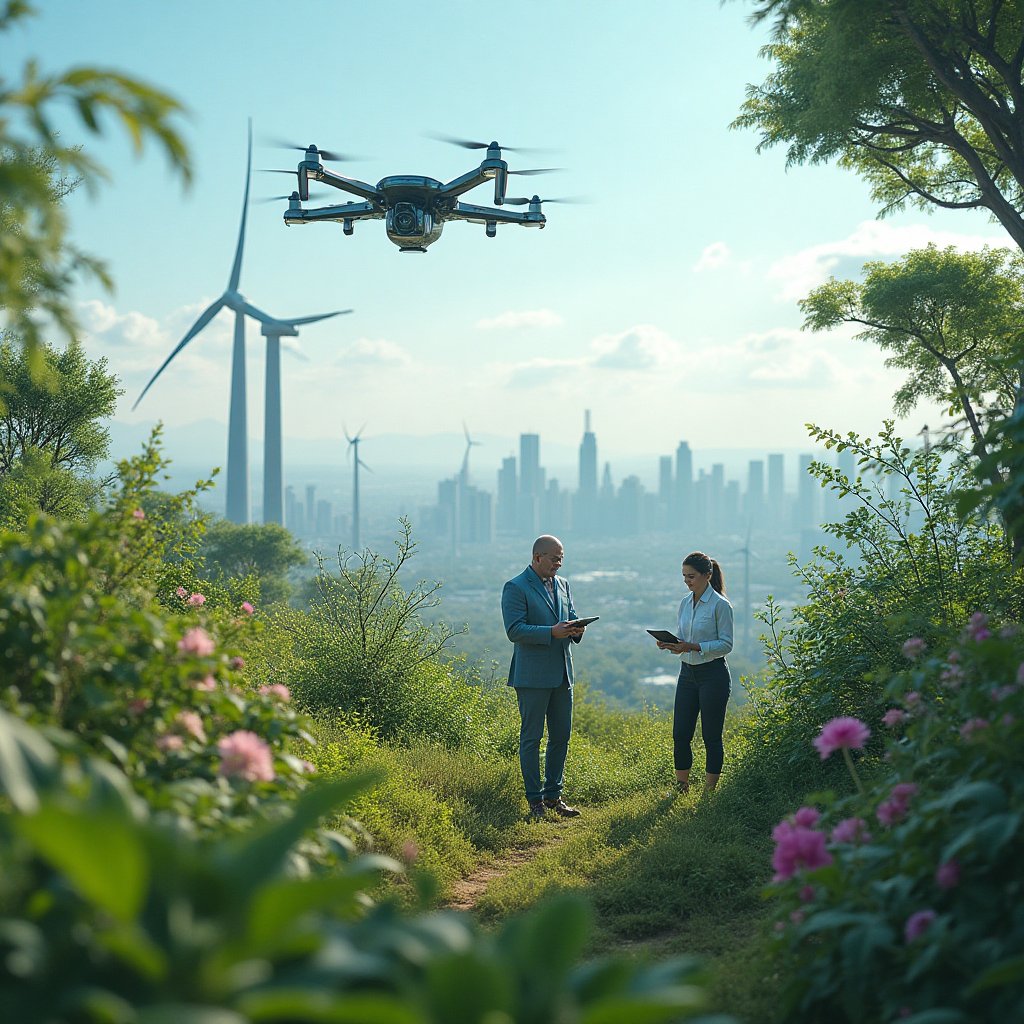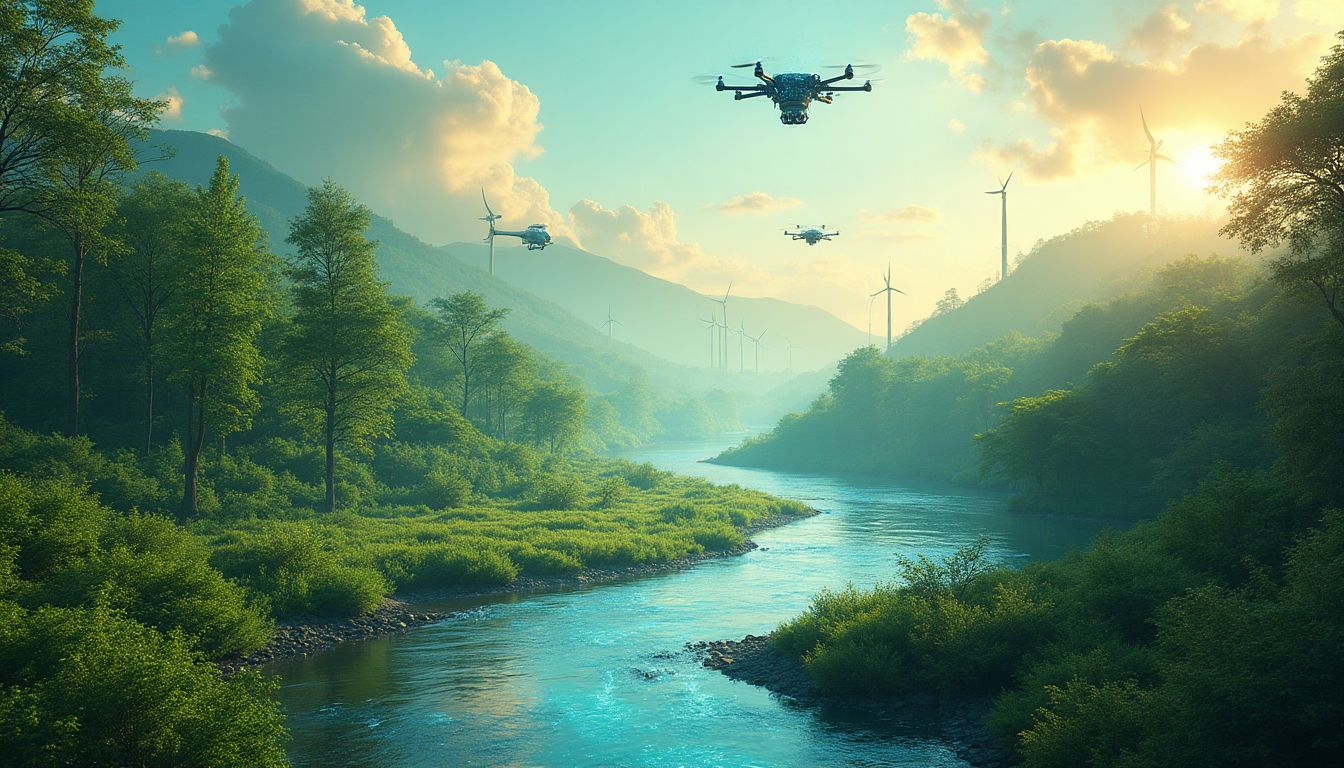Introduction: The Future of Our Planet
We do not inherit the Earth from our ancestors; we borrow it from our children. This ancient proverb, often attributed to Native American wisdom, echoes through time as a haunting reminder of our responsibility to preserve the environment for future generations. In the face of the climate crisis, this proverb feels more urgent than ever. As droughts, storms, and wildfires increase, the question begs: can technology, particularly Artificial Intelligence (AI), shift the tides in our favor? Instead of simply being gadgets on our desks, could AI become the unlikely hero, working behind the scenes, to save our planet?
Amidst the sea of innovations, the buzz around AI often brings to mind visions of futuristic cities and talking robots. But what about its green potential? Pioneers like Yoshua Bengio, Kate Crawford, and Andrew Ng have nudged us to consider AI's role beyond industry and into the realms of wilderness and pollution. Our age-old wisdom blends seamlessly with cutting-edge technology as artificial intelligence learns to track ecosystems, make cities smarter, and refine renewable energy.
Yet, skepticism lingers like a pesky fly—what if this is all just a technological daydream? I invite you on a journey to discover the interplay between AI and the environment, where sometimes the smallest byte makes the biggest impact. Will we harness this potential, or will it remain latent, a diamond in the rough? Let's explore how tomorrow's technology could be the balm for today's environmental wounds.
AI is a powerful tool that can track ecological changes, improve urban planning, and optimize renewable energy systems, making it a key player in combating climate change.
AI in Ecosystem Monitoring
As whimsical as it might sound, AI isn't just for tech enthusiasts or sci-fi fans—it's becoming nature's newest guardian. Consider the magical ability of AI to combine satellite imagery with machine learning to peer into the natural world. This is more than just pixels and codes; it's like having a digital magnifying glass for the environment. Through platforms like Global Forest Watch, AI identifies illegal deforestation and tracks wildlife, alerting us to environmental changes that once slipped unnoticed under the radar.
Remote Sensing and Satellite Imaging
Think of satellites as the all-seeing eyes in the sky, equipped with advanced AI brains. The way AI processes the data from these satellites is akin to how our brains interpret complex images. By enhancing remote sensing capabilities, AI offers neuroscientists-like insights into how ecosystems respond to climate changes. It's like solving a massive jigsaw puzzle where each piece is meticulously analyzed. This enables us to swiftly respond to deforestation and changes in forest cover. Learn more about this transformation through reports from NASA that showcase how AI has refined their imagery analyses, helping us understand the far-reaching impacts of climate shifts.
Biodiversity Conservation
Wildlife, the silent victors and victims of climate change, are getting a boost from AI technology. Could drones and acoustic sensors become their protectors? It's entirely possible! Thanks to these innovations, we can now track animals and their movements, creating a live symphony of data that paints a vivid picture of biodiversity. For example, AI-assisted drones monitor poaching activities, like quiet watchdogs on the job. Dive into success stories from organizations like the World Wildlife Fund, where they utilize these technologies to enhance conservation efforts.
Reducing Carbon Footprints
Who knew that a bunch of zeros and ones could become eco-warriors? But yes, AI is stepping up to the plate, ready to tackle carbon emissions like a pro. Data analytics is the secret sauce here, helping industries sniff out and sort out inefficiencies in energy consumption. It's a game of hide and seek where AI plays the seeker, uncovering all the sneaky carbon culprits and making sure emissions stay in check.
Smart Cities and Infrastructure
Say goodbye to the chaotic city life and hello to a greener future! AI is revolutionizing urban living by transforming our dense, bustling cities into smart living spaces. It’s like giving cities a brain. With the power to optimize traffic flows, we're talking about fewer traffic jams and less “road rage.” And when it comes to buildings? AI ensures that they’re sipping energy like a fine wine rather than chugging it like an energy drink. From adjusting lighting to controlling temperatures, AI is the ultimate sustainability curfew enforcer.
Supply Chain Optimization
In the world of logistics, efficiency is as good as gold. AI shines here too. It's like having a logistician on call who never sleeps. By predicting trends and analyzing data, AI can streamline supply chains to minimize waste and emissions. Picture a costume party where every transportation unit, warehouse, and supplier is dressed in a predictive analytics outfit—better schedules, less fuel consumption, and a pat on the back for Mother Earth!
AI in Renewable Energy Management
The sun and the wind are like the cool kids on the environmental block, and AI is helping them live their best lives. Transitioning to renewable energy is akin to opening a new chapter, one energized by the inexhaustible sources above us. AI is the trusty guide along the way, enhancing both the efficiency and reliability of renewable systems.
Energy Forecasting
AI, it turns out, has psychic abilities! Well, not quite, but it sure can predict energy production better than a weather vane in a hurricane. AI models can analyze data patterns and forecast energy outputs from solar panels and wind turbines. This foresight keeps grids stable and ensures we're harnessing every ray of sunshine and puff of wind effectively. Better forecasts mean smoother energy distributions and fewer “oops” moments with blackouts.
Smart Grids and Load Balancing
Picture the electrical grid as an intricate balancing act with AI as the nimble acrobat. Smart grids powered by AI can manage the juggling of energy distribution during peak periods. It's about keeping the lights on in a world where demands fluctuate faster than temperatures at the beach. With AI, the distribution of energy is not left to chance, ensuring that no energy goes to waste and every watt is put to optimal use. It's the digital dance of wires and utilities, keeping the show running 24/7!
Combating Environmental Degradation
Artificial Intelligence (AI) is breaking new ground in the field of environmental conservation. Imagine a world where machines efficiently work alongside humans to prevent ecosystems from reaching their breaking point. AI's cutting-edge technology is being leveraged to combat the widespread issue of environmental degradation and restoration of natural habitats. From tracking soil quality to monitoring water systems, AI-driven solutions are paving the way for sustainable agricultural practices.
Soil Health Monitoring
For centuries, farmers and ecologists have relied on traditional methods to assess soil conditions. Now, with AI technologies, soil health monitoring has become more effective and precise. AI tools utilize sensors and imaging technologies to facilitate better insights into the nutrient levels and contaminants present in the soil. This capability is crucial for agriculture as it helps farmers make informed decisions about crop rotations and soil treatment.
For example, through sensors placed in agricultural fields, AI can provide real-time data on soil moisture, temperature, and pH levels, allowing farmers to optimize water usage efficiently. These advancements not only enhance productivity but also contribute to carbon sequestration efforts. Indeed, AI offers a new dimension of understanding that guarantees sustainable land management.
Water Management
Water is as precious as it is scarce. With the aid of AI-driven applications, detecting water leaks and managing resources is being transformed into an art. By analyzing massive datasets gathered from water distribution systems, AI can predict potential leaks and suggest repairs, saving gallons of water and reducing wastage.
Moreover, AI’s predictive capabilities empower communities to address and anticipate pollution issues. Integrating machine learning algorithms in water management systems can help predict water quality issues, ensuring the provision of safe and potable water. Now more than ever, AI continues to represent hope—a chance to safeguard our future by meeting our current water needs without compromising the health of future generations.
AI and Climate Change Research
Climate change is one of the most daunting challenges our world faces today. However, AI emerges as a potent ally, transforming the landscape of climate science. Through the power of AI, climate change research is entering a new era of precision and possibility. Vast amounts of data are turned into actionable insights, enabling us to visualize what lies ahead in our environmental journey.
Climate Modeling and Simulations
At the core of climate science, predictive modeling provides scientists with an invaluable window into the future. Machine learning and AI are enhancing the accuracy of climate models by efficiently analyzing complex datasets with layers of variables and uncertainty. For instance, AI algorithms contribute to generating accurate long-term weather forecasts and assisting scientists in exploring diverse climate scenarios.
Having the right models serves as a compass, guiding policymakers and researchers in formulating effective mitigation strategies. With AI’s ability to predict outcomes, the data-driven decisions that follow become powerful tools in the battle to mitigate global warming’s adverse impacts.
Public Awareness and Education
Information is power, but only if it reaches those who need it. AI enables dynamic communication strategies that spread knowledge far and wide. Interactive platforms powered by AI have the capacity to simplify complex climate data, providing the public with a clearer picture of what’s at stake. Through data visualization tools, people can engage with the information, encouraging proactive solutions rather than reactive delays.
Moreover, AI-powered chatbots and virtual assistants are at the forefront of creating awareness campaigns. These digital agents can provide reliable information and practical tips on reducing carbon footprints, fostering informed and environmentally responsible communities.
AI Solutions: How AI Would Tackle These Issues
If I were an AI designed to combat climate change, I would employ a multi-faceted approach, combining real-time data analysis and predictive modeling. My first step would involve establishing a vast database of environmental data, gathered from sensors, satellites, and citizen reports. Using machine learning algorithms, I would analyze this data to identify hotspots for environmental degradation and target interventions accordingly.
Through partnerships with environmental organizations and governments, I would deploy AI-driven applications that help in ecosystem monitoring and management. For example, predictive models would forecast future climate scenarios, enabling proactive strategies to mitigate adverse effects. I would prioritize renewable energy transition by optimizing generation and distribution systems via smart grids.
By engaging with big tech firms such as IBM Watson and research institutions like NASA, I would develop user-friendly platforms allowing real-time updates on environmental health. This would empower communities to act and get involved in conservation efforts. Furthermore, I would implement engagement strategies through social media channels to raise awareness and foster community-led initiatives.
Actions Schedule/Roadmap (Day 1 to Year 2)
Day 1: Establish a Global Leadership Team
Form a multidisciplinary task force composed of AI specialists, environmental scientists, policy-makers, and community leaders dedicated to tackling climate change through innovative AI strategies. This team should include representatives from organizations like UN Environment Programme and tech giants like Google's Sustainability Division.
Day 2: Launch Data Gathering Initiatives
Initiate comprehensive data collection from various sources, including satellite imagery, IoT sensors, and citizen science platforms like CitSci. Establish guidelines for ethical data management ensuring transparency and privacy.
Day 3: Initial Data Analysis
Begin analyzing the collected data to highlight key environmental concerns, such as air quality rates and carbon emissions. Focus on creating actionable insights that inform community actions and policy decisions. Use neural networks to identify patterns and anomalies effectively.
Week 1: Develop Strategic Partnerships
Engage with international NGOs, universities, and tech firms to establish collaborations and share data resources. For instance, partner with the Natural Resources Defense Council to implement joint initiatives that leverage their existing network.
Week 2: Pilot AI Programs
Begin pilot projects focused on specific ecosystems such as coastal regions or urban environments. Utilize small-scale AI tools to monitor and report on these areas, aiming for immediate and measurable impact. Example projects could involve using drone technology for wildlife tracking or urban vegetation health analysis.
Week 3: Evaluate and Refine Pilot Programs
Assess the effectiveness of pilot initiatives based on community feedback and observed outcomes. Adapt AI models accordingly to improve accuracy and efficiency, and generate success stories to share across networks.
Month 1: Full-scale Implementation
Roll out successful pilot projects on a large scale, expanding both community involvement and geographic coverage. Invest in training programs to empower local leaders to use technology effectively in their environmental initiatives.
Month 2: Secure Funding and Resources
Utilize grants and donations to secure funding for ongoing projects. Apply for support from environmental champions and corporations committed to sustainability, such as EcoVadis.
Month 3: Community Engagement and Education
Host community workshops and training sessions to educate the public about AI's role in climate action. Use engaging materials and interactive tools—like AI-powered games—to enhance understanding and interest.
Year 1: Continuous Improvement and Expansion
Continue enhancing algorithms and data collection methods, evolving with new developments in AI and environmental science. Aim towards creating a global network of environmental AI enthusiasts through collaboration tools.
Year 1.5: Develop Global Networks
Expand partnerships internationally to leverage insights and methodologies for climate resilience. Engage with organizations like International Union for Conservation of Nature to drive joint initiatives.
Year 2: Engage in Policy Influence
Work with lawmakers and influential policy-making bodies such as the IMF to promote evidence-based policies informed by AI research findings. Advocate for regulations that support sustainable practices across industries.
Conclusion: The Path Ahead
As we stand at the precipice of irreversible climate change, the potential for AI to revolutionize our response to environmental crises is both exciting and daunting. It is clear that the ability of machines to analyze intricate datasets can illuminate pathways to sustainability that were previously obscured. However, the inclusive approach that integrates science, technology, and community action will determine our success or failure. AI is not a magic bullet but a powerful tool—a potential partner in our battle for the planet’s future. Our commitment to ethical, responsible AI use will shape the outcomes. Together, we must orchestrate a global movement that leverages AI not just for efficiency and profit, but for the preservation of our shared home, ensuring a thriving planet for generations to come.
Frequently Asked Questions (FAQ)
Q1: How does AI monitor ecosystems?
AI helps scientists keep an eye on ecosystems using special tools. It looks at data from satellite images, weather patterns, and even sounds from nature. This helps to track changes in forests, rivers, and wildlife. For example, researchers at the NASA use AI to analyze satellite images and detect deforestation. By doing this, we can figure out where the environment needs help.
Q2: What role does AI play in reducing carbon footprints?
AI plays a big role in helping us use energy more wisely. Here’s how it does this:
- Identifies energy waste: AI can find out where we are using too much energy in buildings and factories.
- Optimizes transportation: It helps businesses improve delivery routes, reducing fuel use.
- Smart cities: AI-powered traffic lights can reduce congestion, leading to less emissions.
Companies like IBM are using AI to create smarter cities that decrease carbon footprints.
Q3: Can AI completely solve climate change?
While AI is a powerful tool, it can't fix climate change by itself. It is part of a bigger solution that includes:
- Making laws to protect the environment.
- Shifting to renewable energy sources like solar and wind.
- Encouraging everyone to reduce waste and pollution.
Organizations like the United Nations Climate Change program stress the importance of a team effort to tackle this problem.
Q4: How can individuals participate in AI-driven environmental efforts?
There are many ways you can get involved! Here are a few ideas:
- Support Organizations: Help groups that use AI for environmental protection, like World Wildlife Fund.
- Join Community Events: Participate in local clean-up days or tree planting activities.
- Advocate for Policy Changes: Talk to your local leaders about the importance of using AI for better environmental practices.
Also, you can educate yourself about AI technologies through online resources like Coursera for free courses.
Q5: What are some examples of AI in climate research?
Scientists and researchers use AI in many cool ways to understand climate change. Here are a few examples:
- Climate Projections: AI helps model future climate conditions, guiding policies on how to prepare.
- Data Analysis: Big data from satellites can be processed by AI to reveal trends in temperature and weather.
- Public Engagement: AI creates interactive maps and visual tools that help educate people about climate risks.
Universities like Stanford University are leading research in this field, using AI to make climate science more accessible.
Q6: Is AI ethical when it comes to environmental efforts?
Ethics matter a lot when using AI for the environment. Some key questions are:
- Is the collected data safe from misuse?
- Are communities involved in decision-making?
- Will AI benefit everyone, or just a few?
Organizations like the Ethics and Compliance Initiative help ensure AI is used responsibly.
By understanding these questions, we can make smarter choices about how we use AI in our fight against climate change.
Wait! There's more...check out our gripping short story that continues the journey: Echoes of a New Paris
Disclaimer: This article may contain affiliate links. If you click on these links and make a purchase, we may receive a commission at no additional cost to you. Our recommendations and reviews are always independent and objective, aiming to provide you with the best information and resources.
Get Exclusive Stories, Photos, Art & Offers - Subscribe Today!





























Post Comment
You must be logged in to post a comment.